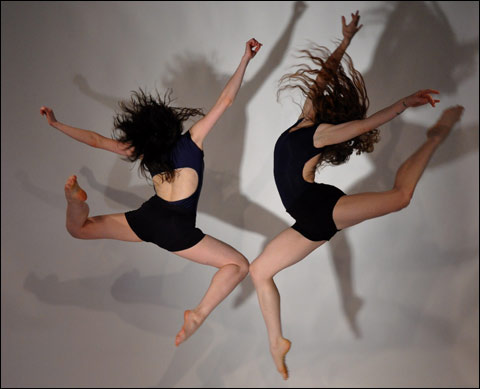Antoniou222.jpg)
GUKARAHUNDI Watching Chipaumire through the scrim was like looking at a dance through a movie. |
Nora Chipaumire’s lions will roar, swans will fly, angels will wrestle heaven, rains will break: gukarahundi, presented at the ICA last weekend by CRASHarts, had the makings of a multimedia extravaganza. Accompanied by projections, moody lighting, dancing partner Souleymane Badolo, and Afropop musicians Thomas Mapfumo and the Blacks Unlimited, Chipaumire seemed to be aiming for a collaborative reflection of her experience and Mapfumo’s, as Zimbabwean expatriates and exemplars of inadvertent globalization.
When Chipaumire appeared here four years ago, on a program of women’s solos at Summer Stages/Concord, we saw a tremendous performing persona channeling her energy into carefully chosen images. gukarahundi, for all its impressive components, seemed diffuse and even diminished in comparison. It looked to me more like a string of numbers that may or may not have been related, a variety show.
Mapfume and his four companion musicians sat in a row in one half of the stage, in a very dim light. Sometimes they played alone; sometimes the dancers would come out of the dark and move in what space was left. At the beginning, Chipaumire materialized in front of them and spoke, unmiked, in a seductive undertone, giving a travel commercial, perhaps. Smiling, she’d get more enthusiastic, a little louder, a little sarcastic, then subside to a whisper. A billion percent inflation rate. Welcome to Zimbabwe. Life is good. Life is good.
After this introduction, she went on to do a series of seemingly noncommittal dance sequences with Badolo. The beguiling, insinuating character who’d opened the evening didn’t return until the end, when, in a luscious solo, she went slowly from pose to pose, with interludes of fast stepdancing and shimmy shakes. Peeking at the audience to make sure we were getting it, she turned our voyeurism back on us. Bill T. Jones used to play this game in his solos, manipulating the audience’s pleasure, sympathy, guilt. Chipaumire’s dance seemed indulgent rather than sharp, but it took place, like the whole performance, behind a protective scrim, so maybe that softened the edges.
Images projected on this scrim — animated raindrops, flocks of birds, clouds and smoke, op-art designs — partially screened whatever the performers were doing. Sometimes there were no projections, but the scrim stayed in place. The ICA’s Barbara Lee Theater is quite small, a black box, with the first row of seats right up against the performance space, and no proscenium or curtains. The idea is to open up the theater experience by bringing us into intimate contact with the performers. Chipaumire’s scrim play (credited as “video design by Romain Tardy and early design by Joelle Dietrick”) created an intervention of massive proportions. It was like looking at a dance through a movie.

SANITAS The Contrapose dancers gave Gianni Di Marco’s work more intensity and high energy than anything else on the long program. |
Inside the scrim, lighting designers Olivier Clausse dit Maurice and Joe Novak kept things so dark, the dancers often seemed little more than glimmering phantoms. Gradually the space grew light enough for one to detect big differences in style between them. They were about the same size. In fact, Chipaumire gave Badolo her jacket at one point in her final solo, and he put it on, becoming a kind of alter ego.